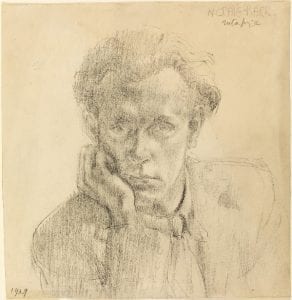Spotlight on the Slade: New findings
By Martine Rouleau, on 17 May 2017
Blog post written by Helen Downes, Paul Mellon Centre Research Curator

UCL6602 Portrait of a Man, 1939 by Nancy Dorothea Craig-Barr. © Estate of the artist. Name inscribed at upper right.
Exciting findings continue to emerge from UCL Art Museum’s Spotlight on Slade, the research and cataloguing project generously supported by the Paul Mellon Centre for Studies in British Art.
Recent findings have unearthed new information about Slade artists and have focused attention on the cataloguing process itself and how artists, subjects and meanings can be subsumed and potentially lost through the process of cataloguing.
As I work through the Slade Drawings collection, looking at each work, checking and updating title, date and artist information, I am also recording the numerous inscriptions on the works. These can range from artist signatures to notes by the student or the tutor, a scribbled record of a prize won or a subject drawn. Many record the old ‘Slade No.’ which corresponds with the original Slade record slip detailing the artist, title, subject and prize awarded. A whole group of works have been carefully inscribed by Randolphe Schwabe (Slade Professor 1930 – 1948). Interesting itself is how the ink has faded and its constituency altered, now appearing as if pencil has been meticulously and precisely overwritten in ink.
On finding ‘Portrait of a Man’ (UCL 6602), it was the hand-written name that enabled correct identification of the artist. Listed in the catalogue as by Barr, N. Craig, the inscription ‘N. CRAIG-BARR’ suggested a different name format – and not necessarily a male student as supposed in the catalogue record. The student file held in the UCL Records Office provided confirmation: Nancy Dorothea Craig-Barr, born 1919, attended the Slade 1937 – 1940 to study Drawing, Painting and Design. She won certificates for Drawing, Design, History of Art, Painting and Perspective. So far, research has found nothing else, but, crucially, her work is now correctly catalogued and the door to further research has been opened – without that, we would not even have known these few facts about her time at the Slade.
An accurate artist name is critical to further research. Contact with relatives of former students is also an important way of learning more, not only about the biographies of the artists but also about their work and subject matter. Henry Inlander (1925- 1963; Slade 1949 – 1952) won First Prize (equal) for Summer Composition in 1951 for his work Paradise Lost Book XII (the Expulsion from Eden) and we have a number of his works in the collection. One, a work recorded (uncertainly) as ‘Court Scene’ has always appeared slightly incongruous alongside the other works.
Now, thanks to the opportunity to meet with the artist’s nephew and his family, the etching can be correctly recorded as a scene within a synagogue. Shortly after the end of the Second World War, the Red Cross tirelessly located and gave news to members of families who had been separated – relatives of loved ones who had been taken into forced labour or to the concentration camps. Inlander’s etching illustrates how Jewish people sought refuge, comfort and safety within the synagogues, sometimes sleeping there. He depicts himself as the central figure on the right. Such an important personal and historical record can now be recorded accurately within our catalogue – and, as a teaching collection, the value of the story it tells is manifold.
While the research and cataloguing continues, we are also focusing on collections care and access. A conservation audit of the Slade drawings has begun and we will be continuing with photography and digitisation of those works for which we don’t yet have images, so that more of this unique collection will be visibly accessible online.
Keep checking our website for information and updates and if you have a specific enquiry please contact Helen Downes, Paul Mellon Centre Research Curator at ucwedow@ucl.ac.uk
 Close
Close


